
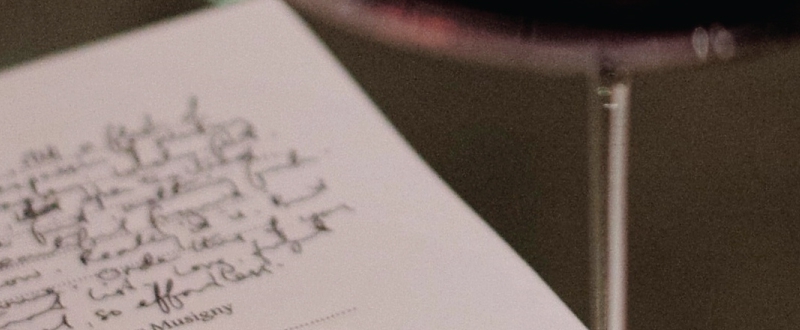
© Linden Wilkie, 14th May 2021
What struck me in this tasting – Alex’s passion for and knowledge of these wines aside – was the diversity of styles and expressions on offer from the United States. All six wines were of very high ‘fine wine’ quality, worth your attention. We tend to think of Burgundy as offering a diverse range of terroir-driven Pinot Noirs, and that’s true. But in the Côte d’Or, we are really talking about different types and amounts of limestone, various amounts of topsoil, slope position, proximity to cold air (the ‘combes’), and relative exposure to the sun. In comparison, the United States AVAs in Oregon and California offer a much wider diversity of soil types, elevations, and influences. Sure, the final range of suitable spots is naturally small for this famously finicky grape, but those spots are well spread out. And these six wines really laid it out for those of us in attendance – Willamette Valley, Russian River, Sonoma Coast, Santa Cruz Mountains, Santa Rita Hills… the point really hit home for me when Alex discussed the ‘winds so strong you have to fight the door to get out of your car and your eyes fill with dust and grit’ in Santa Rita Hills, and the high altitude vineyards that work because they are above the fogline that affects so many others lower down. Here, in the United States is a diverse world for Pinot Noir to offer the Burgundy enthusiast a wider play to discover.
Secondly, we tasted from vintages spanning 2017 back to 2000. It’s clear that despite a common misconception that ‘New World Pinot doesn’t age’ they really do. It’s just that the ones made in sunnier climates can also have wonderfully gorgeous fruit while young, and soft tannins that make them a delight young. We imagined drinking a slightly chilled 2017 Lucunda Russian River Valley out on the terrace on a sunny Hong Kong afternoon, and I think that would be a perfect way to enjoy it. On the other hand, the 2014 Kosta Browne ‘Gap’s Crown’ Sonoma Coast, while drinking well, is already more interesting than it was when I last tasted it in 2017. I think this, the 2014 Rhys ‘Alpine’ Vineyard from Santa Cruz in particular are the kind of Pinots I would go deeper on, to drink, and to cellar further. I bought a couple of bottles of the Rhys for myself to follow up with.
Finally, and this should come as no surprise, the Pinot Noir domaines in Oregon and California are each following their own path in viticulture and winemaking, and within even just this set of six we could see the bookends of that, with Véronique Drouhin’s (of Maison Joseph Drouhin, and Domaine Drouhin in Oregon fame) emphasis on delicacy, charm and finesse in her 2014 Caballus from Willamette Valley, and Helen Turley’s emphasis on phenolic ripeness, and concentration from low yields in her 2000 Marcassin Estate ‘Blue Slide Ridge’ Vineyard at the other end. Just like in Burgundy, the key is to find a producer whose approach you like, and then explore their range.
I learned a lot from Alex’s presentation, and these wines lined up. Also, having just come back to Hong Kong to live after some time in Singapore, I really loved the K11 MUSEA lounge space The Fine Wine Experience now has. The team there are pouring great wines by the glass, and there’s a great selection of bottles to enjoy there or take away, and there’s also a neat ‘Thirsty Thursdays’ wine tasting series to join.
I’d encourage you to pull up a comfy chair, and read Alex’s really informative report and tasting notes - linked, and attached here, perhaps with a glass of Pinot Noir in hand. Below you will find my own tasting notes on the wines Alex presented. We have some very interesting bottles in stock, so, why not broaden your exploration of this great grape?
2014 Caballus Pinot Noir, Willamette Valley OR
Fresh ruby still with a hint of youthful blue to the tone; dark raspberry, fruity nose; lovely fruit, ripe and melting with a musky note. This is a complex and stylish Pinot Noir, with delicacy and airiness. Really refined. Should continue to cellar very well.
93
2017 Lucunda Pinot Noir, Russian River Valley CA
Light ruby; a ripe, open and fruity expression on the nose, ripe plump fruity expression, with ripe, and some slightly candied notes, and some heft, this remains well-balanced, berry and cherry fruit, and a hint of brown spice. This is a round-textured, fleshy, friendly Pinot Noir, brimming with fruit, that can be enjoyed now.
91
2014 Kosta Browne ‘Gap’s Crown’ Pinot Noir, Sonoma Coast CA
Fine clear ruby; lovely nose, fresh with floral notes, beetroot and raspberry aroma, enticing; succuluent on the palate with a rounded texture and good concentration, very fine, elegant, and well-balanced. Lovely freshness. This has a candied texture and taste in the attack, and turns more earthy and cool toward the finish. Superb balance and real palate-coating flavour, fulsome but certainly not heavy at all. Drinking well.
94
2014 Rhys ‘Alpine Vineyard’ Pinot Noir, Santa Cruz CA
Fine hued ruby; wonderfully perfumed, very floral at first, red fruits, savoury notes – a mouthwatering nose; gorgeously musky-scented fruit, fresh, cool, fresh-ripe, with a fine grip running through the palate. The nose grew and grew, fine and airy, with a cool sort of refreshing note like the scent of a pine forest in summer, or perhaps something minty. Great juiciness on the palate – the highest acidity in the flight – with a touch of beetrooty coolness too, and so much musk in the mix. This is quite special.
95
2009 Sea Smoke ‘Southing’ Pinot Noir, Santa Rita Hills CA
Clear, fairly deep colour; a ripe nose, roses, candied cherry fruit; sweet on the palate, lush, with a clear element of fine oak in the flavour and in the texture, immaculate quality of fruit, concentrated and fine. More obviously ‘California’ than either the Kosta Browne or the Rhys. It needed even more (additional) air than the others to reveal complexity. This is clearly in the sweeter spectrum of aroma and taste. Ripe dark cherry fresh fruit tart. There’s more thickness to the velvet slightly muscalur tannins – Alex explained that it is a wind-swept location, which helps to explain this point. Very persistent finish.
92
2000 Marcassin Estate ‘Blue Slide Ridge’ Vineyard Pinot Noir, Sonoma Coast CA
Deep semi-opaque garnet; sweet candied fruit, candied orange peel, earth notes and some exotic spices; concentrated and dense on the palate, tannic/extracted, ripe and exotic, this is punchy in style, exotic in flavour, quite medicinal in fact, like an Amarone with a little negroni character too – sweet bitter herbs and candied oranges. (Others remarked about Chinese medicine). Full, rich, spicy Pinot Noir.
I did not rate this bottle as it was the lesser of the two bottles served. It will appeal if you like well-made concentrated, spicy, exotic wines.

© Alexandria Rae Cubbage, 14th May 2021
Last Saturday, I took some of you on a journey exploring the top wine regions in the U.S. for Pinot Noir. Our journey didn’t require any travel only a bit of creative imagination envisioning yourself at each of these vineyard sites as you sipped the Pinot Noir from your glass. Linden came too. Below is a bit of background on the development of Pinot Noir in the U.S., information about these specific wines and my tasting notes too as well as the results of our vote on favourite wine of the tasting. We hope it inspires you to take your own little escape on a Saturday afternoon with a bottle of U.S. Pinot Noir. Travelling to Oregon or California is still quite difficult right now, but you can still enjoy some of their delicious wines.
We began our U.S. Pinot Noir discussion by talking about some of the main differences we find between Pinot Noir from Burgundy and Pinot Noir from the U.S. For example, we find more ripeness and alcohol in the Pinots from the U.S. while in ones from Burgundy we find more acidity and the tannins stand out a bit more.
Pinot Noir cuttings were brought to California around the 1850s, and Gustav Niebaum planted Pinot Noir at Inglenook in 1880. Then, in the 1950s, Martin Ray would be the person recognized for first making a 100% Pinot Noir wine of quality. In the 1940s he planted Pinot Noir and Chardonnay grapes at Mount Eden in the Santa Cruz Mountains.
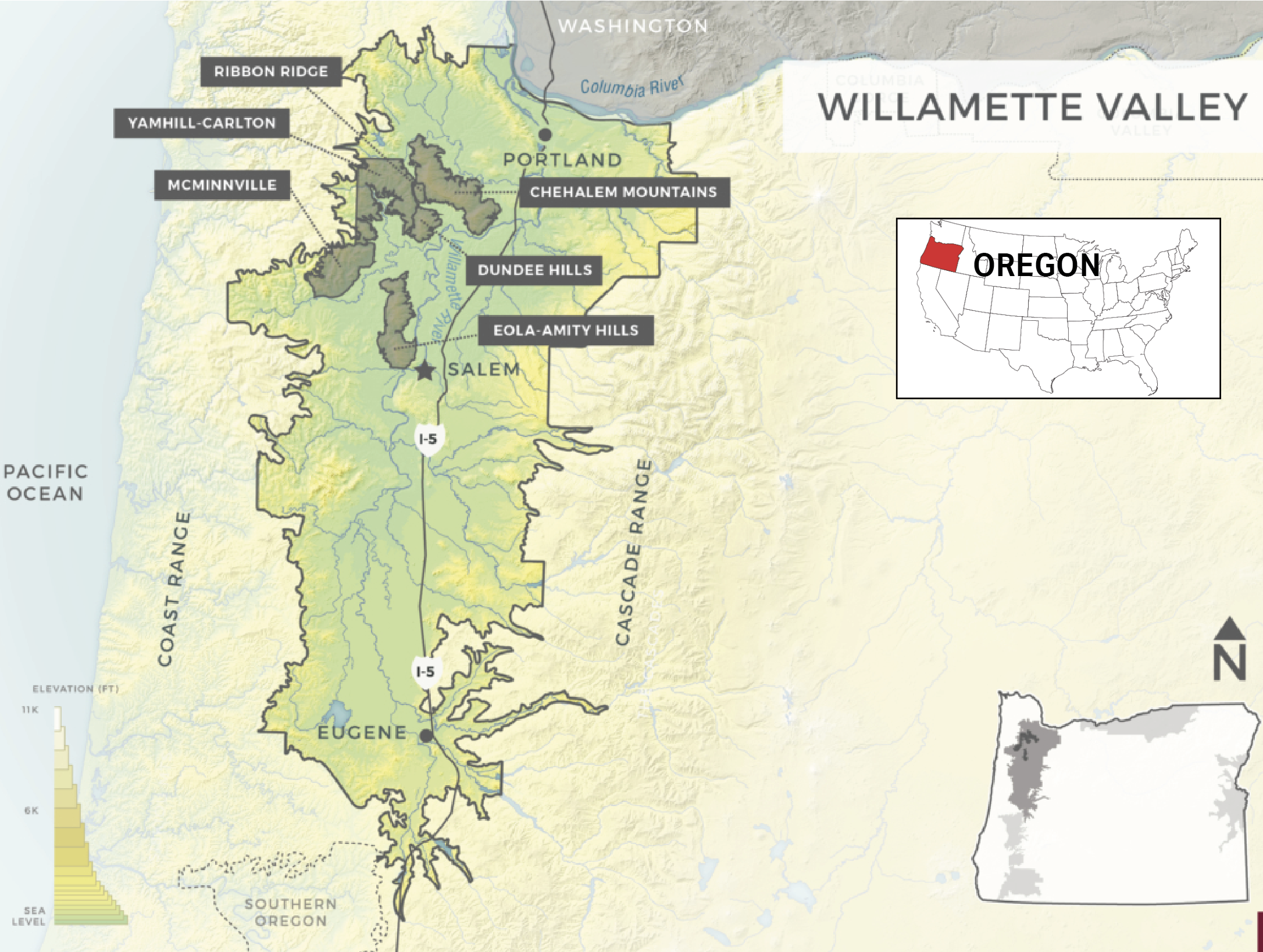
We began our discussion and tasting of U.S. Pinot Noir in Oregon. David Lett who started Eyrie Vineyards in the Dundee Hills sub-American Viticultural Area (“AVA”) of the Willamette Valley is the person who put Oregon Pinot Noir on the map. The Willamette Valley became recognized as an AVA in 1984, and then became further subdivided into smaller AVAs with Dundee Hills being established in 2004. David Lett brought Pinot Noir cuttings up from California in search of a cooler site to plant Pinot Noir. Lett planted vines in 1965 with his first crop in 1970. In 1979 a famous French food and wine magazine organized a special wine competition in Paris called the ‘Wine Olympiad’. Lett entered his 1975 Eyrie Vineyards South Block Reserve Pinot Noir, and it came in third place to the surprise of all the Burgundians who had put their best wines into the competition. Not able to believe it, the next year Robert Drouhin organised a second competition in Burgundy and again a bottle of Lett’s wine was included. This time the Eyrie Vineyards’ bottle came in second, so Pinot Noir from Oregon garnered acceptance on the world stage. By 1987 Robert Drouhin had established a winery, Domaine Drouhin in the Dundee Hills. In an interview for Oregon Pinot Camp, Véronique Boss-Drouhin, daughter of Robert Drouhin and winemaker for Domaine Drouhin, spoke about how her father took his first trip to the West Coast of the U.S. in 1961. His wine distributor drove him up the West Coast, and he was so surprised when he got to Oregon because of how similar the valley was to Burgundy.
And in fact, Oregon shares a few things in common with Burgundy including being located on the same latitude at the 45 North Parallel. The light that Oregon has is similar to the light in Burgundy, and Oregon doesn’t receive the heat with that light that California does. However, Oregon experiences warmer temperatures in July and August than Burgundy. And while Oregon does experience diurnal shifts in the temperatures between the day and night time those shifts aren’t as dramatic as in California. In general Oregon’s Willamette Valley, where most of the Pinot Noir is made, is cooler than California, so the wines tend to show fresher fruit aromas and more acidity than the wines of California. Also, rainfall in Oregon is similar to Burgundy except that the rain in Oregon all happens within nine months; there is no rain during June, July and August. The vineyards in Oregon are planted on hillsides not on the valley floor because the soil on the valley floor is too rich for grape vines. It will produce too many grapes of poor quality, so the valley floor is planted with other crops like blueberries and hazelnuts that do well in these soils. As a result of these weather conditions and where the grapes are grown, the Pinot Noirs that are produced in Oregon’s Willamette Valley tend to be lighter and more earthy in character than the Pinots from California. They also tend to have fresh fruit aromas and more acidity.
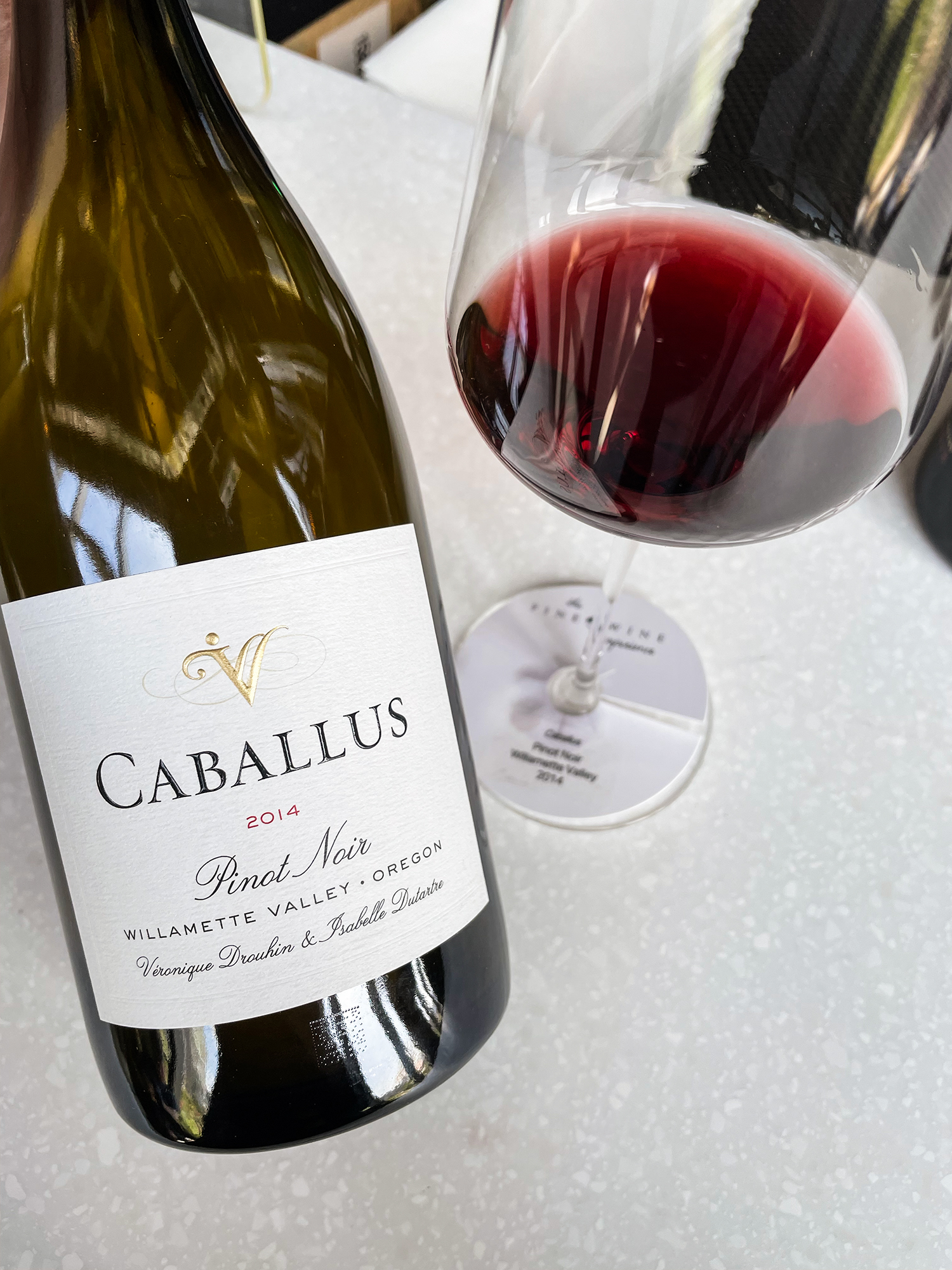
2014 Caballus Pinot Noir Willamette Valley
As our example of a wine from Oregon’s Willamette Valley, I chose 2014 Caballus Pinot Noir. It’s a tiny production wine made by two friends, Véronique Boss-Drouhin of Maison Joseph Drouhin in Beaune and Domaine Drouhin in Oregon and Isabelle Dutartre of De Ponte Cellars and 1789 Wines in Oregon. They met at a riding club in Beaune thirty years ago, and the name ‘Caballus’ is the word for horse in Latin. Isabelle worked with Véronique making wine at both Maison Joseph Drouhin and Domaine Drouhin.
Caballus is made with grapes from two of Willamette’s best AVAs – Dundee Hills and Eola-Amity Hills. In the winemaking, they use wild yeast for fermentation and then age the wine in French oak barrels approximately one third of which are new. Production is tiny (approximately 220 cases per year), so the focus in making the wine is on quality over quantity.
The 2014 vintage in Oregon was known for being a hot vintage and a large crop. Winemakers describe the Pinot Noirs from this vintage as being ready to drink and accessible right from the start.
Tasting notes:
There is some sweet fruit here, so the wine is indicative of its Willamette Valley terroir; you won’t mistake it for Burgundy. But, the wine isn’t big, powerful and alcoholic. Rather, it shows aromas and flavours of red and dark cherries, liveliness in the fruit, red berries combined with savoury herbs. You feel the acidity on the palate, and it makes you want another glass. The elegant style of Drouhin comes through in this wine too. This wine received one vote for favourite wine of the tasting.

California’s Russian River Valley is a cool climate area in northern California in Sonoma County where grapes like Chardonnay and Pinot Noir grow well. This area became recognized as an AVA in 1983. The history of grape growing in the Russian River Valley dates back to the 19th century, but in the 1970s is when you really start to see commercial bottlings from specific estates.
The primary influence on the ripening of the grapes in the Russian River Valley is the fog that comes in during the night time through the Petaluma Wind Gap. It’s a maritime fog coming off the Pacific Ocean that rolls in at night and will cause the temperature to drop 35-40 degrees from the temperature during the day. What this does is it extends the growing season here to 15-20% longer than other regions in the area. Then, for the wines, they will be juicy and supple because of the warm days while still retaining acidity from the cool nights. In general, the Pinot Noirs from California tend to be richer and denser than those of Burgundy.
For the Russian River Valley, the flavour profile can usually be described as having a cola note, baking spices, red and dark fruits and a sarsaparilla root or root beer like aroma. Jeff Mangahas, the winemaker at Williams Selyem, describes the wines of the Russian River Valley as having a more consistent tannin profile to those of the Sonoma Coast. And he also describes the Pinot Noirs of the Russian River Valley as having more tea flavours whereas the Pinot Noirs of Sonoma Coast have more coffee flavours. Usually, the wines of the Russian River Valley have more succulent fruit and are juicy, rich wines.
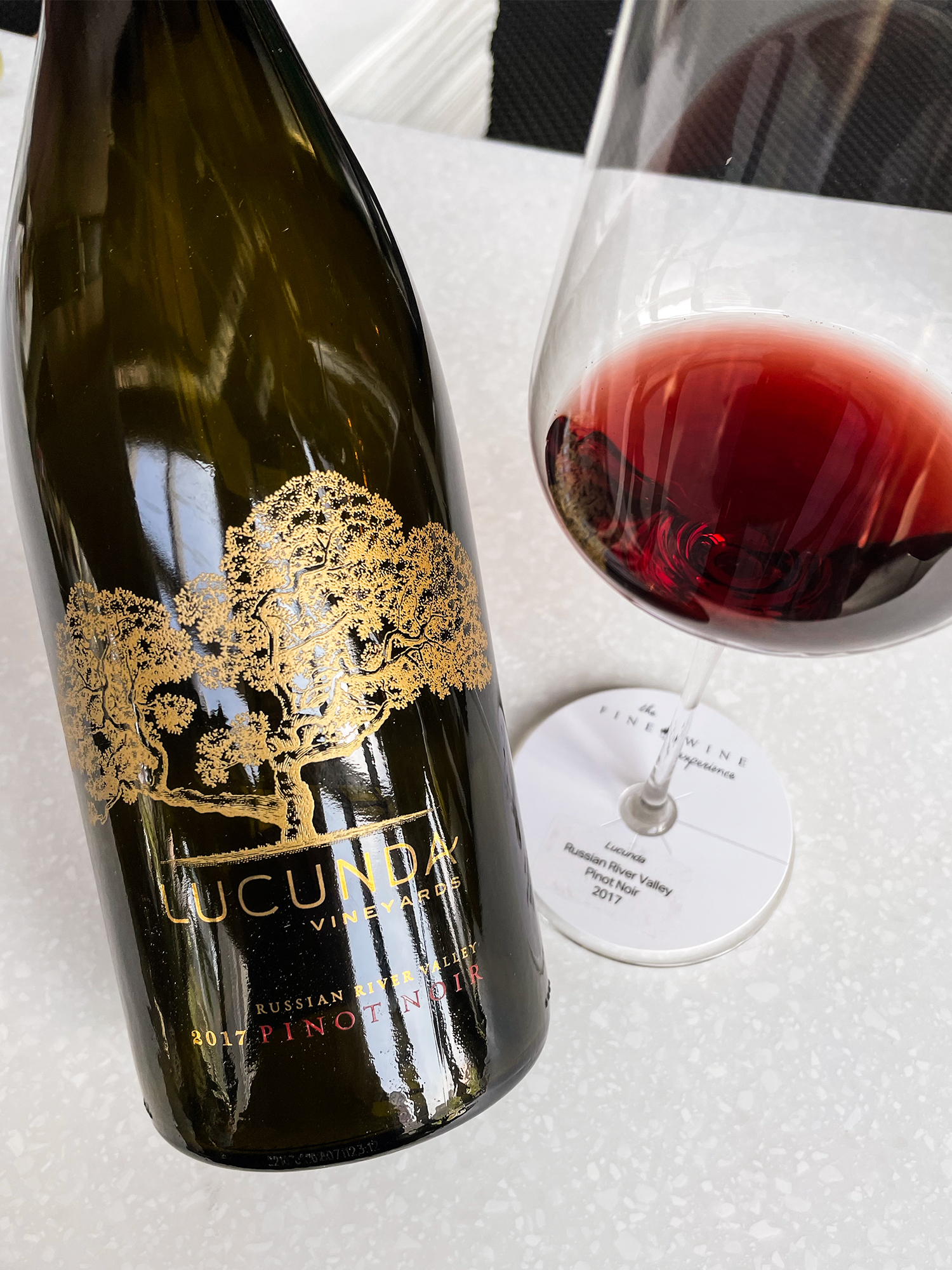
2017 Lucunda Russian River Valley Pinot Noir
For our example of a Pinot Noir from the Russian River Valley, I chose 2017 Lucunda. It’s a new project owned by Hong Kong couple, Esther and Derek Chan, with the 2017 being their first vintage. They love the expression of Pinot Noir in Burgundy but wanted to create a wine with more consistency which they find to be true of American wines. In 2016, the Chan’s purchased 20 acres of vineyards in the Russian River Valley. The vineyards contained 16 acres (6.47 hectares) of premium Pinot Noir vines that were about 20 years old. This vineyard is located on Starr Road in Windsor, California in the heart of the Russian River Valley. Other producers that you likely know which are situated close by are Kosta Brown’s Amber Ridge Vineyard, Gary Farrell’s Starr Ridge Vineyard and Kistler. Prior to the Chan’s purchase of this vineyard, the fruit was sold for wine production.
The winemaker is Cabell Coursey who has worked as winemaker and consultant for wineries in major regions throughout the world including working at Domaine Méo-Camuzet, Domaine Hudelot-Noëllat, Felton Road, Dry River, Beaux Frères, and Kosta Browne. The Chan’s have capped the production at 3000 bottles a year. In the winemaking, the wine is aged in French oak barrels with 50% being new, and there is no fining or filtration done in making this wine. They only grow Pinot Noir.
Esther and Derek chose the name “Lucunda” because it’s derived from a Latin word meaning “pleasant” and “delightful”. They believe that the true style of Pinot Noir is delicate and intense with an astonishing taste and bouquet. These qualities are what they aim to achieve in Lucunda.
Tasting notes:
The 2017 Lucunda showed aromas of sweet baking spices, darker fruit with more berry flavours and more alcohol and weight felt on the palate. Tannins were rounded and velvety with a juicy, mouthcoating quality to the fruit. This wine received one vote for favourite wine of the tasting.

The Sonoma Coast AVA was established in 1987 and is a large AVA that stretches all the way from Mendocino down to the San Pablo Bay. The area is known for having a cool climate and heavy rains; the vineyards here can receive more than twice the annual rainfall of the vineyards located further inland like in Russian River Valley. When winemakers like Helen Turley and her husband John Westlaufer started planting grapes here in the early 1990s, some people thought they were crazy because they believed it was too cold for grape ripening. But, most of the vineyards are located above the fog line, so indeed the grapes are able to ripen. The grapes of Sonoma Coast are mountain fruit, and the vineyards can be located at elevations of up to 304 metres. They tend to experience cooler days and warmer nights than in the Russian River Valley. The climate and the different topography of the vineyards here produces a very different grape profile than the Pinot Noir grown in the Russian River Valley. In general, the Pinot Noir of the Sonoma Coast tends to be more savoury, earthy in character with deeper, darker fruit notes and more structure.

2014 Kosta Browne ‘Gap’s Crown’ Pinot Noir
For our example of Pinot Noir from Sonoma Coast, I actually chose two wines– 2014 Kosta Browne ‘Gap’s Crown’ and 2000 Marcassin ‘Blue Slide Ridge’ which we tasted at the very end. Kosta Browne began almost twenty years ago through the dream of two guys, Dan Kosta and Michael Browne, who met working at a restaurant in Santa Rosa called John Ash and Co. They soon learned they shared a common vision of making Pinot Noir. Now, Kosta Browne is considered to be among the top producers for Pinot Noir in the U.S. They’re located in the Russian River Valley. Kosta Browne makes four appellation Pinot Noirs – Russian River Valley, Sonoma Coast, Santa Rita Hills and Santa Lucia Highlands. They make nine single-vineyard wines and two winemaker series wines.
The ‘Gap’s Crown’ Vineyard is one of Kosta Browne’s single vineyard wines located in the Sonoma Coast AVA with a northeast orientation and steep, rocky terrain (elevation ranges up to 240 metres high). One of the distinguishing features of the Sonoma Coast AVA like the Russian River Valley is the influence of the Petaluma Gap. The ‘Gap’s Crown’ Vineyard is located here, and in this area, the late season fog gets trapped and takes a longer time to burn off. As a result, this fog enables a longer hang time for the grapes, producing more balanced and evolved flavours in the resulting wine.
For the ‘Gap’s Crown’ Pinot Noir, the goal is to keep the fresh flavours of the place, so fermentation is done predominantly in stainless steel with a small portion in concrete (16%). Then, ageing takes place in a combination of French oak barrels (25% new) and 16% in concrete vats. Ageing of this wine is for approximately sixteen months.
Tasting notes:
This wine showed a darker fruit character with herbal notes of thyme, an earthy aroma of autumn leaves, roasted coffee and a toasty quality. I felt the tannins in this wine more, and the fruit wasn’t supple and rich like the Lucunda. This wine received six votes for favourite wine of the tasting, and it came in second overall.
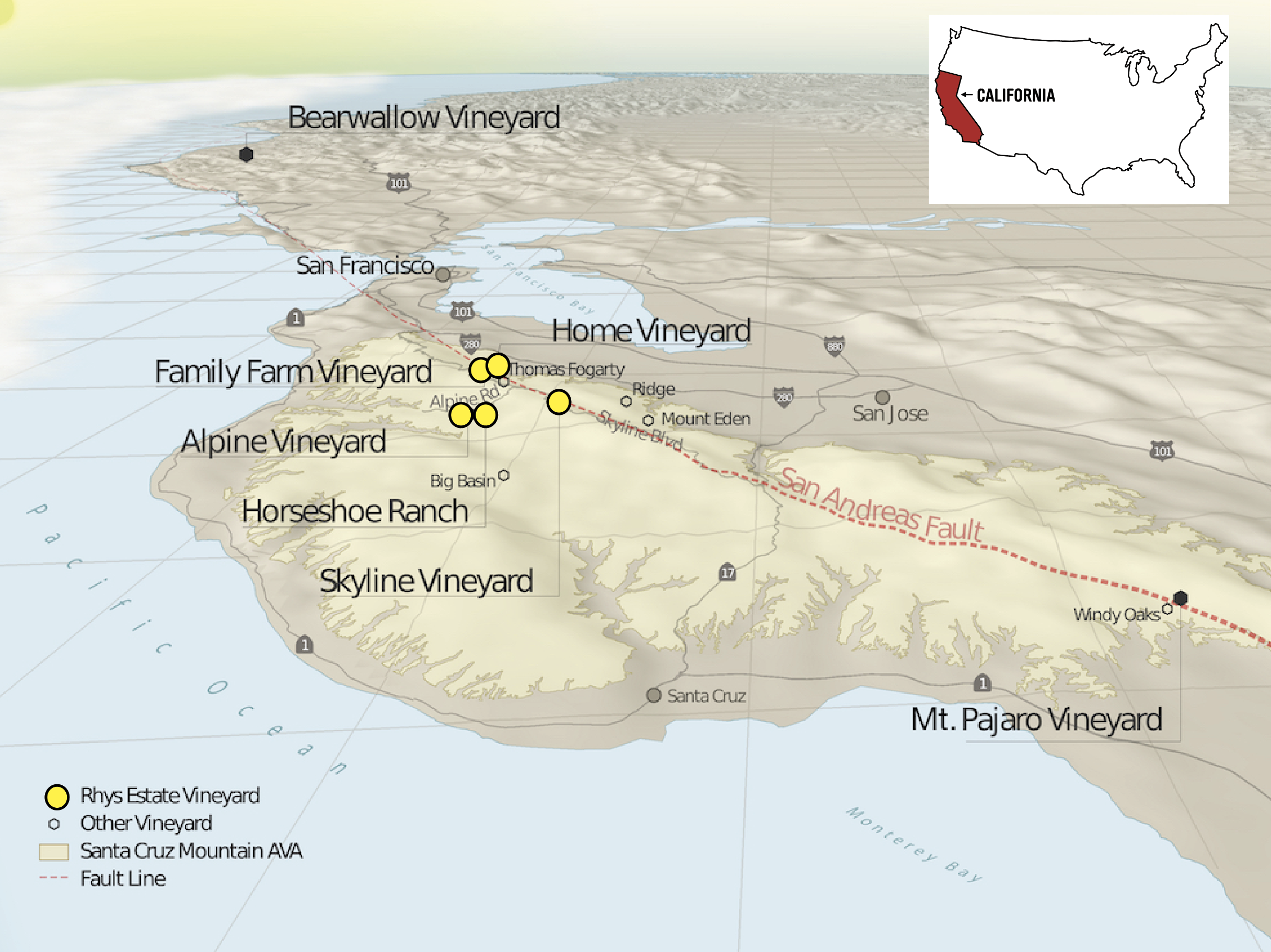
The Santa Cruz Mountains received AVA status in 1981. While the Santa Cruz Mountains has a long history of grape growing and is where Pinot Noir in the U.S. likely first became famous through Martin Ray and the vines at Mount Eden, it was a difficult place to grow grapes initially. Another icon of this AVA is David Bruce, and he planted his vineyard in 1961. One of the difficulties early on was that only about three out of ten vintages would produce ripe grapes, so the wines were often rustic, tannic and not pleasing on the palate. The grapes are grown in small, high altitude vineyards surrounded by redwoods and forest. The general flavour profile of the resulting wines is herbal aromas with more red fruits, bright acidity and a minerally tension throughout the palate.
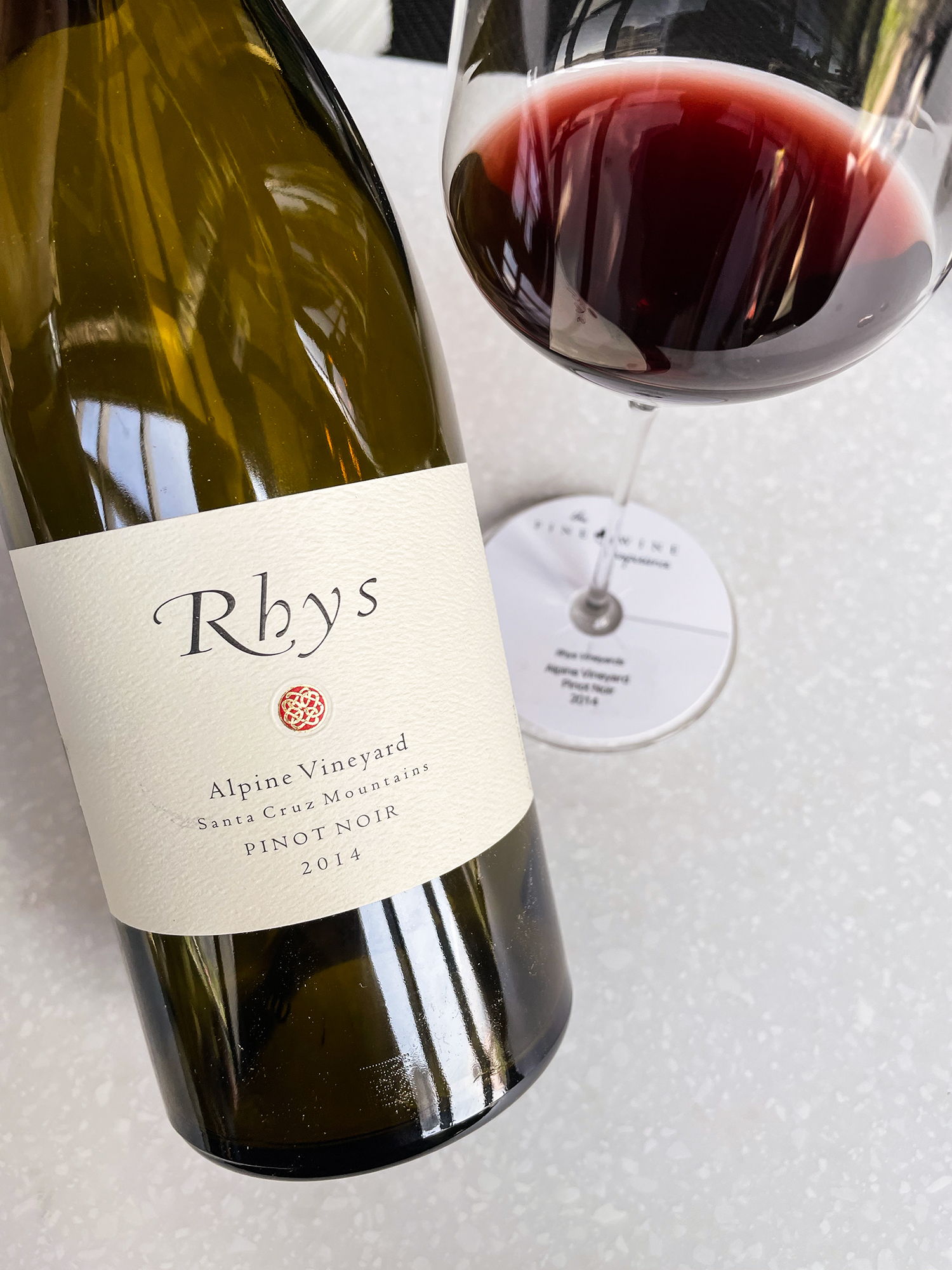
2014 Rhys Vineyards ‘Alpine’ Vineyard Pinot Noir
For our example of a Pinot Noir from the Santa Cruz Mountains, I chose 2014 Rhys Vineyards ‘Alpine’ Vineyard. At Rhys Vineyards they specialize in making top quality Pinot Noir, Chardonnay and Syrah in California. It’s owned by a Burgundy lover, Kevin Harvey, who had a successful software and finance career that enabled him to establish his own winery. The winemaker is Jeff Brinkman.
In the vineyard, they use a combination of organic and biodynamic farming practices. The philosophy at Rhys is that great wine is made in the vineyard not in the winery.
For the winemaking they use practices such a foot treading and native fermentation using the natural yeasts found on the grapes when they’re brought in rather than adding any nutrients. In addition, they ferment in small one-ton tanks, so they can ferment by small sections of the vineyard.
Rhys is made up of seven estate vineyards. Six vineyards are located in the Santa Cruz Mountains and one vineyard is located in Anderson Valley.
In California, 2014 is an outstanding vintage for Pinot Noir, and Rhys is one of the producers Decanter highlights as being one of the best producers of the vintage for Pinot Noir.
Tasting notes:
For the 2014 Rhys ‘Alpine’ Vineyard Pinot Noir, I smelled more red fruits in my glass, wild strawberries and red and dark raspberries with bright acidity. There was an herbal note of tarragon and a fresh and lively tension through the palate. This wine received ten votes for favourite wine of the tasting, and it won for the favourite wine.
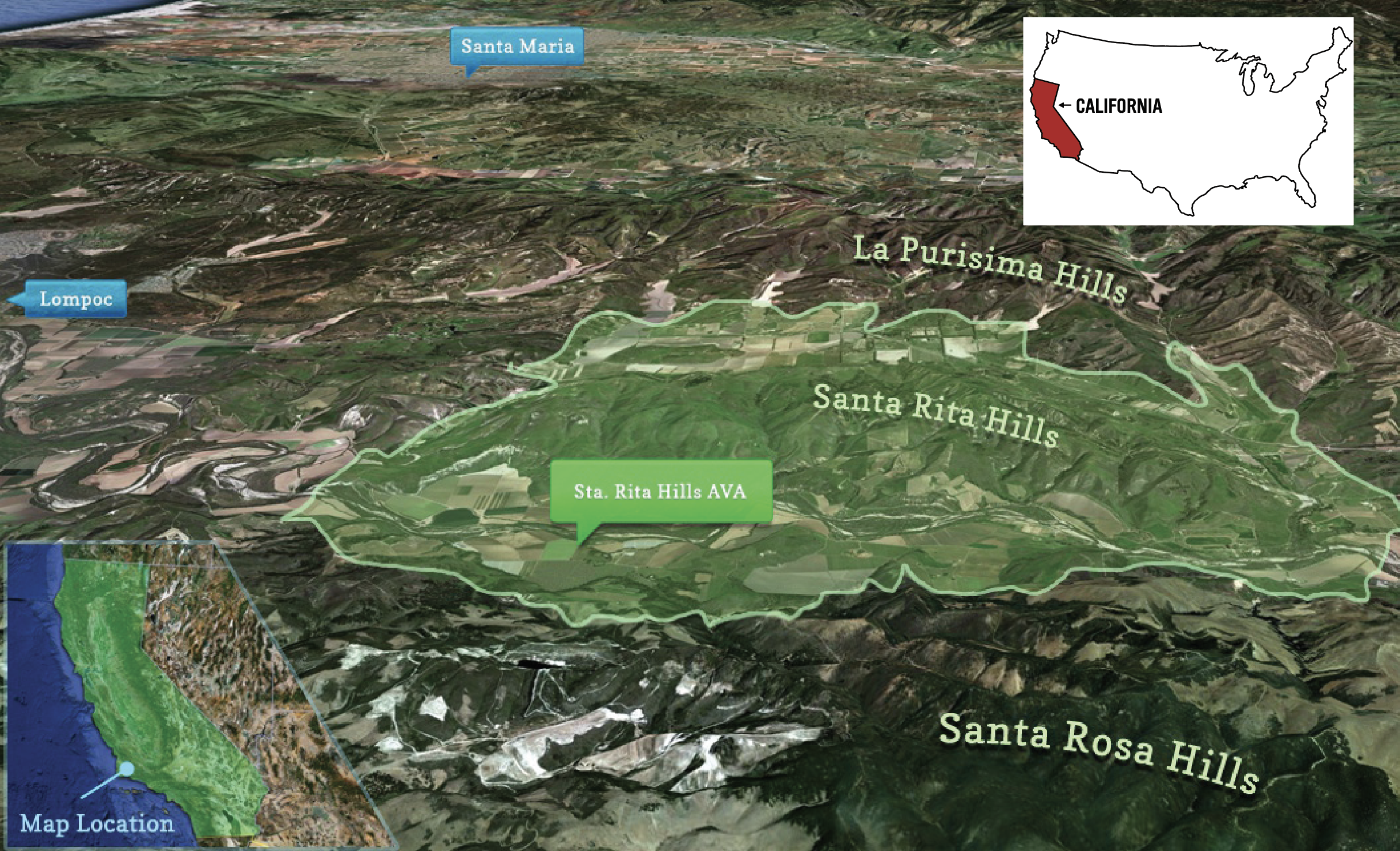
Most of the wineries in Santa Rita Hills have just sprung up within the past 10 to 15 years. It received AVA status in 2001. However, it’s where some of Santa Barbara’s earliest vines are located. The Sanford and Benedict vineyard was planted in 1971 and is famous for its Chardonnay and Pinot Noir. I really like the Chardonnay from this vineyard, especially in the hands of Jim Clendenen at Au Bon Climat. The climate of the Santa Rita Hills is cool, foggy and windy. In fact, when I visited Domaine de la Côte several years ago, I had to close my eyes because of all the dust being blown up by the wind as I walked into the winery to taste the wines. In this area, they experience a long, cool growing season with heat spikes that don’t happen until late September and October. So, like Sonoma Coast, some wine experts worry that vineyards won’t receive enough warm temperatures to ripen the grapes. Because of the climate and orientation of the vineyards, Pinot Noir from the Santa Rita Hills tends to have a floral and aromatic nose, more red fruit character with concentration, and the tannins tend to be grippy but not in a bad way.
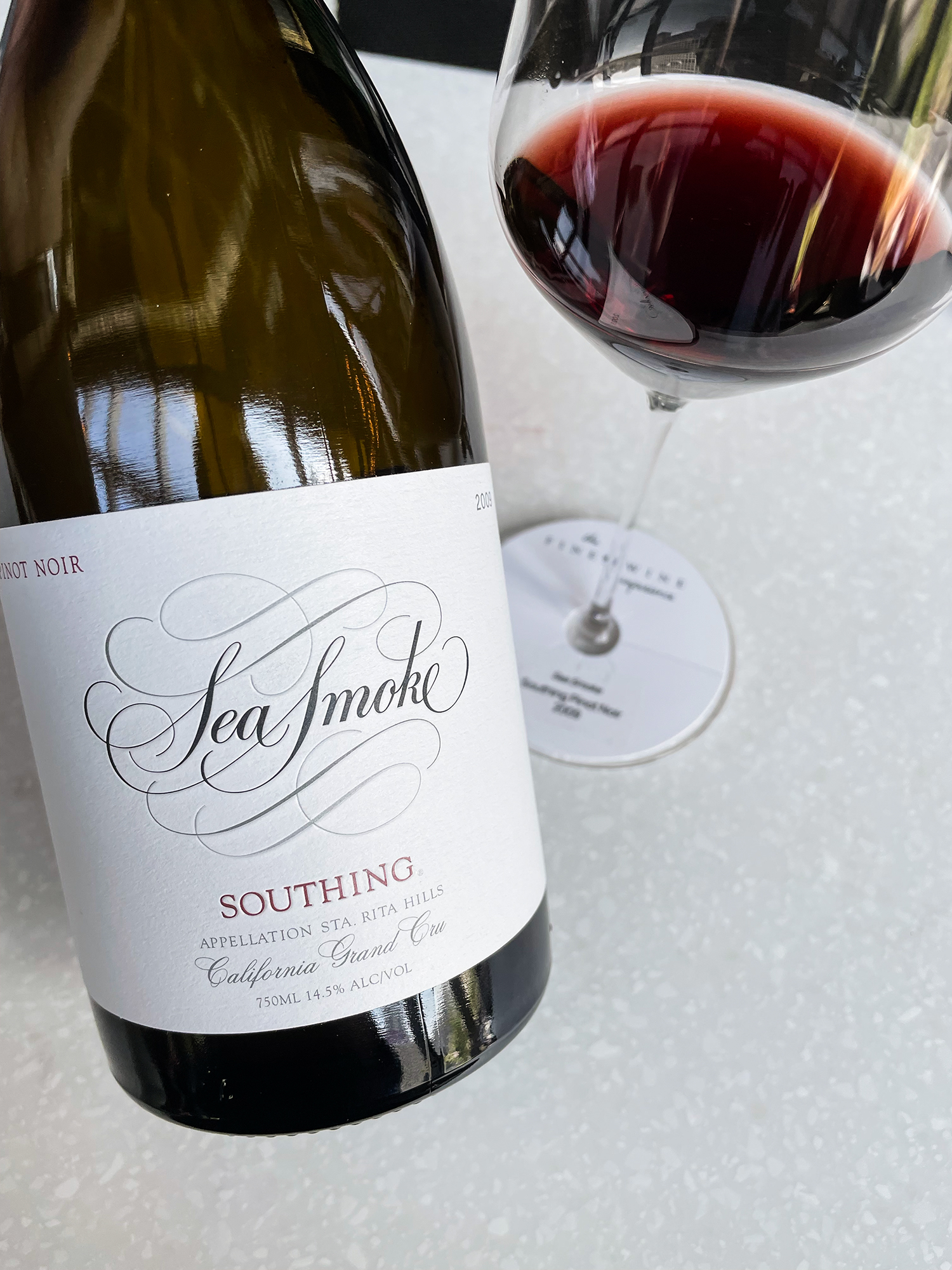
2009 Sea Smoke ‘Southing’ Pinot Noir
Sea Smoke was established in 1999 by Bob Davids. He had long dreamed of owning a winery that would produce world class Pinot Noir and eventually he found this vineyard site to carry out this goal. At Sea Smoke, currently, they produce two Pinot Noirs – ‘Southing’ and ‘Ten’ – and a Chardonnay as well as a sparkling wine called ‘Sea Spray’ which is a Blanc de Noirs. Sea Smoke’s vineyards are located in the western end of Santa Barbara’s Santa Rita Hills AVA; this area is known to have the perfect microclimate, soils and exposure to grow top Pinot Noir.
More specifically, the south-facing vineyards are planted on hillsides with elevations ranging from 107 to 198 metres, so these vines get ideal sun exposure promoting favourable flavour and tannin development. In addition, the location of the Sea Smoke vineyards is unique because they fall within one of the only east to west coastal ranges in the United States. That means within this area the cool marine fog layer that normally sits over the Pacific Ocean is actually drawn into the vineyards. Sea Smoke has the Santa Rita hills bordering it to the north with the Santa Rosa hills and the Santa Ynez range to the south, this canyon acts as a funnel and draws in the marine fog over the vineyard land. The winery takes its name from this weather condition; the fog layer is referred to as sea “smoke”. So, what happens in the end is the heat felt by these wines during the day is then moderated at night by the fog layer, cooling the vines and enabling a longer, more gradual ripening period.
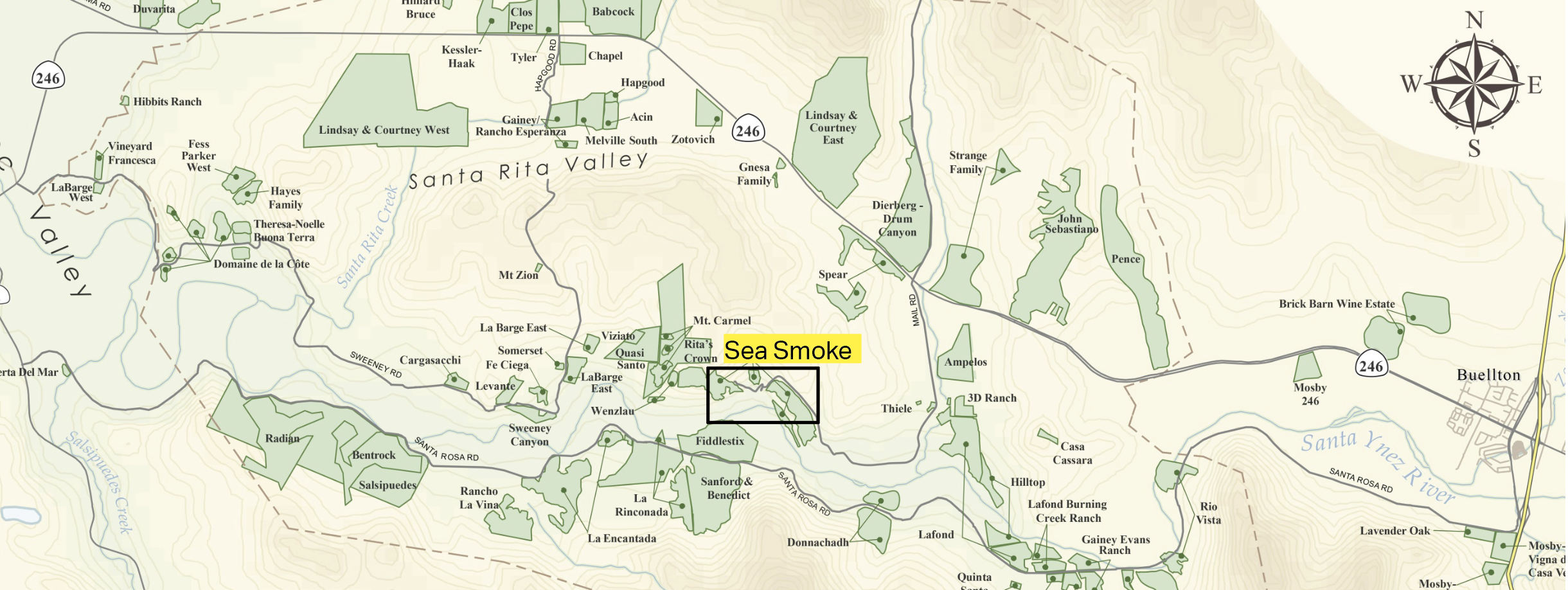
The soils and the way that the vines are planted are other keys to the high quality Pinot Noir produced at Sea Smoke. With the aim of low crop yields and small grape clusters to produce wines with intense flavour, top-quality Pinot Noir clones have been selected and put on vigor-reducing rootstock. These vines grow in rich clay soils. The vineyards are located on hillsides characterized as “buckle” zones which have soils deposited over time by erosion and the weathering of nearby peaks. The soils are shallow here which also helps in reducing the vigor of the grapes and promoting the growth of smaller grape clusters.
For the vineyard practices, Sea Smoke has been farmed sustainably since 2003 and has been participating in the California Association of Winegrape Growers’ Code of Sustainable Winegrowing Practices since then. In 2005, Sea Smoke started farming a special 4.9 hectares block of the vineyard using biodynamic practices and that has now increased to 32 hectares. They have been able to map out the vineyard blocks to determine how to handle each section of the vineyard best, so the grapes are harvested at ideal maturity.
In the winemaking, the grapes are hand-harvested and sorted in the vineyards. Then, they are de-stemmed and sorted on the sorting table. The musts will be inoculated with cultured yeasts to begin a slow fermentation process. Today, we are tasting the ‘Southing’ Pinot Noir which refers to the south-facing hillsides found in the estate vineyard. For this wine, punch downs are done manually twice a day for about fourteen to eighteen days. Then, after the primary fermentation and maceration the wine will be put in tank. After settling, the free run juice and grapes will be pressed very slowly to avoid extracting any bitterness. The free run juice and press wine will be given time to settle overnight and then be racked into barrels. Then, ageing is for approximately sixteen months in French oak barrels with around 55% new depending on the vintage. The 2009 was released in 2011. The aim with ‘Southing’ Pinot Noir is to produce a wine that’s a true expression of the terroir of the Sea Smoke vineyard.
Tasting notes:
The 2009 Sea Smoke ‘Southing’ Pinot Noir displayed aromas of dried roses, dark cherries, forest floor with more of the soil note coming through and a structured feel on the palate. The tannins were there providing balance with the fruit, aromatics and acidity. This wine received four votes for favourite wine of the tasting including mine.

2000 Marcassin Estate ‘Blue Slide Ridge’ Vineyard Pinot Noir
I included this second wine from the Sonoma Coast so that everyone could experience a U.S. Pinot Noir with age and also taste one made by one of the great winemakers from the U.S., Helen Turley. She is a legend as she helped make famous many of the California wines we seek out today such as Martinelli, B.R. Cohn, Turley, Peter Michael, Bryant Family, Colgin, Pahlmeyer, among others. Marcassin Estate is owned by Helen and her husband John Wetlaufer.
Marcassin Estate’s first wine was 1991 ‘Upper Barn’ Chardonnay. They planted Pinot Noir in the vineyards in 1992. And originally when Helen and her husband John began, they didn’t have a winemaking facility. From 1991-2011 the wines were all made at Martinelli where Helen was the consulting winemaker from 1992-2010.
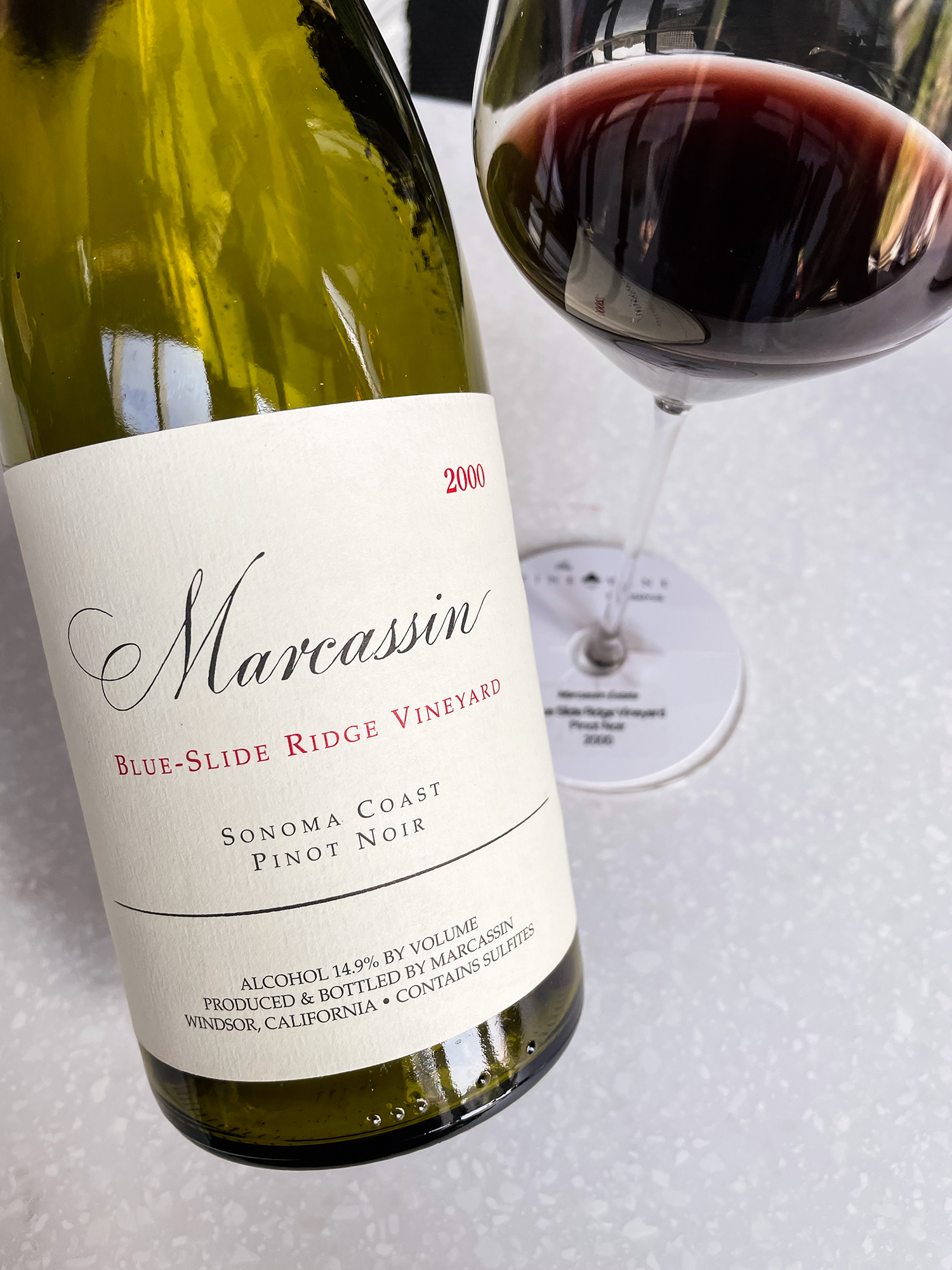
At Marcassin Estate they only grow Pinot Noir and Chardonnay, and it’s a small winery with just 4 hectares.
Only about 100 barrels in total is made each year. Marcassin is the French word for ‘young wild boar’. Helen and John take inspiration from the wines they love from Burgundy with this project. In an interview with Wine Spectator, Helen explained that they planted their vineyard based on taste because ‘for fifteen years she and John were tasting wines made from these clones in other places.’ In the vineyard, they farm meticulously, block by block. Yields are limited, and the grapes are allowed a long hang time. In terms of harvesting, they actually pick their Pinot Noir before their Chardonnay. Picking is done based on taste which is supported by analytical data too. In the interview with Wine Spectator, Helen described, ‘we sample all the clusters, then mash them and taste a glass.’ She explained that at this stage the juice ‘can already have a finish. It shouldn’t catch your throat with acidity. The juice already starts getting some perfume and characteristics like that.’ For the Pinot Noir, she’s also looking at the colour that she sees in the bucket after mashing up the grapes, and that is another factor for determining when to pick.
‘Blue Slide Ridge’ is made from purchased fruit from the Martinelli’s ‘Blue Slide Ridge’ vineyard that borders the Marcassin Estate vineyard. Lee Martinelli, Sr. purchased this plot of land in 1994 to hunt wild boar, but when Helen Turley walked this site she told him, ‘this is a grand cru site for Pinot Noir.’ This vineyard was planted in 1995. The last vintage for Marcassin ‘Blue Slide Ridge’ Pinot Noir was 2007.
For making this wine, the Pinot Noir grapes are de-stemmed and put into fermentation tanks that are consistent with the size of the harvest parcels. The grapes will be cold-soaked and see one pump over per day. Natural yeast is used in the fermentation process, and the wine is left on its lees. Ageing occurs in 100% new François Frères barrels for on average about one year. Then, the wine is normally released about five years after the vintage.
Tasting notes:
The 2000 Marcassin ‘Blue Slide Ridge’ Vineyard Pinot Noir showed notes of bitter herbs, dried and fresh red and dark cherries, red berries, orange citrus with a hint of mushroom. On the nose, the wine reminded me a bit of the aroma of a Negroni. The wine was concentrated with integrated tannins, and it delivered a long finish. This wine received three votes for favourite wine of the tasting.

As we wrapped up and talked about our overall impressions of the wines, what several of you said you were most surprised by was just how different the wines were. Each wine conveyed its place and a distinct profile. These Pinot Noirs weren’t just ripe and alcoholic fruit forward wines that all tasted alike. We also saw that these wines can age through an example from 2009 and 2000. When I began the tasting, I asked everyone not to look for Burgundy in their glass with these wines. And while it’s normal to compare these U.S. Pinot Noirs to Burgundy as Burgundy is our benchmark for high quality, well-made Pinot Noir, you will be disappointed if you look for Burgundy here. But, you may just find something else that you find special too. There are other areas of the world making delicious Pinot Noir, so embrace them for their uniqueness and the attributes they offer in the glass. I encourage you to take your own journey through U.S. Pinot Noir and see what you discover in our list.
